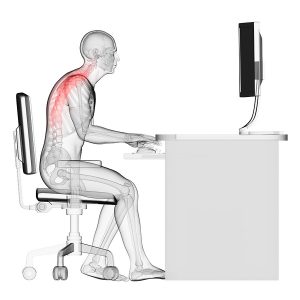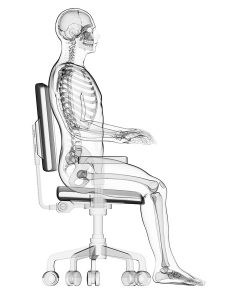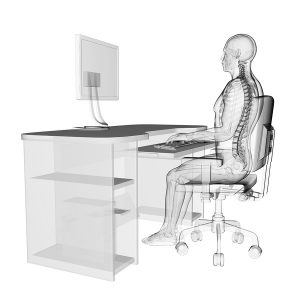You’ve probably seen the typical poster picture of “How you should be sitting at your desk”. And there is a good chance that you already know you should be doing something about the chair you are sitting on. Maybe you’ve thought about getting a standing desk, but you just haven’t gotten to it. Regardless of your desk setup, it is always worthwhile to evaluate the position you spend most of your time in. This is what we call ergonomics. It is the study of people’s efficiency in their working environment with the aim to optimize people’s workspaces and to reduce the risk of injury.
Understanding ergonomics
The word ergonomics comes from the Greek word ergon (which means ‘work’) and the english word economics. Ergonomics is the study of people’s efficiency in their working environment. Basically it is concerned with the ‘fit’ between people and their work. It puts people first, making sure that tasks, equipment and the environment fit each worker. It is involved in two important aspects namely: occupational health and safety as well as productivitiy.
Occupational health and safety
One of the most prevalent types of work-related injuries is musculoskeletal disorders. They result in persistent pain and result in people being unable to do daily activities or go to work. Statistics have shown that millions of people are diagnosed with work-related injuries each year and it leads to millions of people taking time off work. Certain jobs can cause higher levels of undue strain, fatigue and pain that does not go away after overnight rest. These types of jobs often involve repetitive and forceful exertion, like heavy lifting or manual labor. However, it has also been shown that having a sedentary job, like sitting behind a desk the whole day, can be just as straining to your body. Thus, proper ergonomics is necessary to prevent repetitive strain and other musculoskeletal disorders, which develops over time and can lead to long-term disability.
Productivity
When you work in a safe and comfortable workspace, you’ll feel much more productive. Each person has different needs when it comes to comfort and each job will require something different from you. An example of this is the layout of your office. If you constantly have to get up and walk around your desk to fetch documents, it wastes time and energy. If the documents were close at hand, you only have to turn your chair to reach them. This way, you’d get more work done and be more productive. In the end, better productivity at work usually improves the morale of the staff and the income of the company.
Ergonomics isn’t only applicable to work spaces
You can apply the concept of ergonomics to daily life or sport or hobbies as well. Take cycling as an example: If you take time to set up your bike to fit your body, you’ll decrease wind resistance and increase your speed. Not just will you improve your performance, you’ll reduce the chances sustaining an injury. Another example is gardening. Walking to and fro to pick up and throw away leaves causes unncessary strain. But, if you have a wheelbarrow at hand, you can put the leaves in it and save time by throwing everything away at once.
To sum it all up
Ergonomics is something you should pay attention to daily. Ask yourself: “Is this the best or most efficient position for my body?” Don’t only start once you are in pain, because it can even help you to prevent pain and injury.
Why we use ergonomics in our treatment approach
Work-related musculoskeletal disorders can be difficult to diagnose, because typically it doesn’t involve a traumatic accident. Rather, it is constant and repetitive strain and overuse of muscles, joints and nerves. So, if you are not going to look at the position or posture causing the strain, you simply won’t get better.
The biggest problem we face is sedentary behavior, such as spending long periods of time in seated positions. It is a big risk for health problems and musculoskeletal pain. Unfortunately, even though some workplaces make an effort to provide a well designed environment for their employees, any employee who is performing large amounts of sitting will likely experience discomfort at some point.
You cannot always simply change your job, so make your job work for you
That is where we come in. At Well Health Pro we believe that it is very valuable to look at how ergonomics fits into your lifestyle. Not just with your work, but with your daily activities and even sport as well. We use it not just to treat existing pain, but to try and prevent future problems. By incorporating good ergonomic principles in your lifestyle, you can prevent an acute problem from becoming chronic and recurring.
Personalised advice
What’s great about ergonomics is that it can be personalised to your needs and your lifestyle. You’ll find the changes you make much more sustainable if it is applicable to you.
You need someone to guide you through the process of incorporating ergonomics and to evaluate what you need. We can help with that!
Benefits of ergonomics
- Reduces risk of work related injuries
- Higher productivity
- Improved health
- Decreases pain and strain
- Happier employees
- Fascilitate safe movement and work
- Combats sedentary lifestyles
- Encourages self-efficacy
- Easier to return to work after an injury
- Improves quality of life
“Fitting the job to the person”
How will ergonomics be used in my session?
It all starts with an evaluation, centered around your specific problem. Your physiotherapist needs to understand where your pain is coming from and how it is affecting your lifestyle and work. This way, we can incorporate ergonomic advice that is tailored to your situation.
Ideally, an evaluation needs to be done at your work place as well. Certain professions (including certain physiotherapists) can do these ergonomic evaluations, but unfortunately our practice don’t. However, we can write a letter to motivate or recommend that certain changes be made at your workplace to help improve your pain. For example: if you are struggling with back or neck pain, we can motivate that you need an ergonomic chair with enough support for your spine. With a better chair, your work will be more effective.
It’s more than just advice
Ergonimics can be incorporated as advice or as part of your treatment, through exercise. For example: exercises that you can specifically do at your desk to improve posture and help with sitting long hours. One of the best ways to counteract sedentary behaviour is through movment. Think about this… It’s not always about how you sit, but how long you sit.
We’ll use ergonomic principles to make changes to other areas of your life as well. Like addressing how you gym or how you stand while cooking. Ergonomic education happens continuously throughout your appointment, in conjunction with other treatment techniques. It might be small bits of information given throughout your session or could be a longer conversation.
Other ways of incorporating ergonomics:
- Informational pamphlets that you can take home
- Pictures of body positioning
- Example pictures of ergonomic furniture and equipment
- Videos
- Apps and websites
- Workbooks with assignments
- Questionnaires
- Using photos of your workplace to analyze ergonomic setup
Regardless of the way we use ergonomics in your session, it should aim to help you make sense of your pain and manage your surroundings in such a way that it is best for your body.
Positive effects of good ergonomics
Feeling better for longer
Knowing how to use ergonomics in your daily life leads to pain relief that lasts longer. You have better results, fewer complications, less appointments with a medical professional and need less medication and scans. Understanding ergonomics gives you the confidence to manage your pain, making you less dependant on treatment.
Safety
Knowing how ergonomics influence your pain, helps you know what is safe to do and what not. Often patients say: “I’m not sure if I’m making it worse”. That can be confusing and overwhelming. Certain types of pain respond better to movement or stretches and other types respond better to rest. Knowing which positions are best for your condition, will make you feel more in control.
Being more productive
Better ergonomics lead to improved productivity. At work you can concentrate for longer and get more work done. You can exercise with more ease until you’re tired and won’t have to stop because you’re in pain. In the garden you get more done before you have to rest. These are just a few examples of the amazing difference that good ergonomics can make in your life.
Preventing future injuries
Ergonomics, used the right way can prevent pain and injury from happening again. Use it well, learn from your mistakes and your body will thank you.
Negative effects of bad ergonomics
Fear avoidance
When you’re in pain, it’s easy to become fearful of doing certain things. Fearful of bending, sitting too long, walking, working, exercising or even socialising. With time, it’s easier to avoid these things alltogether. It leads to more time away from work and added stress about not working or getting things done. You become stuck in a vicious cycle of doing less and feeling worse.
Compensation
Without you even knowing, your body falls into bad habbits when you’re in pain. An example of this is when you have a stiff and sore neck. You can’t properly look over your shoulder or into your blindspot, so you rather turn your whole body to be able to see. Initially, you do it because you are in pain. But with time, it becomes a habbit and your body starts to compensate for this new habbit. The wrong muscle groups will be working and it leads to more pain and problems.
Overuse
If you don’t know what kind of pain you are dealing with or how to manage it, you won’t know what kind of positions and movements are safe to do. By simply pushing through pain all the time, you can continupusly re-injure yourself or even worsen the pain.
Poor management
Managing your pain with medication or repeated cortisone injections isn’t good for your health in the long term, nor is it solving your problem. Without really addressing your problem, you simply numb it with medication and that is a temporary effect.
How many times should I get ergonomic advice and how long will it take?
Ergonomics can be used from your first session, however it works best if it can be used repeatedly in each of your follow-up sessions as well. A treatment session might include lots of tidbits of information or a longer information session. It is incorporated into your whole treatment (a bit at the beginning, a bit at the end to conclude etc.). Your physiotherapist will evaluate how much information you need, according to your responses. If there isn’t enough time in your session to get to all the discussion points, your physio could even guide you incorporate one or two things at first and continue the discussion in the next session.
What can I do at home to ensure I’m using the advice in the right way?
First and most important. INCORPORATE THE ADVICE! don’t just listen, USE IT. And if you struggle to incorporate it, talk to your physio about it in the next session. You can always take pictures or a video and show it to your physio to help with fully visualising your setup. Be open if you feel some of the advice is not applicable to you, so we can try to plan around it.
With physiotherapy treatment, it is important to comply to the whole treatment plan, including rehabilitation and conditioning. This is the best way to get long-lasting pain relief and address the real underlying problem.
A few things you can do on your own:
- Ask yourself: “Is this the best for my body?” Good posture is about more than finding a comfortable position to work in, or what “feels right.” Especially when you consider that some positions, while comfortable for you, may not be ergonomically correct.
- Change it up. Doing the same movement repeatedly or spending time in the same position continuously cause strain on your body. Alternate tasks or incorporate a break in which you can move and stretch.
- Lift with your body. If your job involves heavy lifting or manual labour, try to use your whole body. Bend your knees and don’t put all of the pressure on your spine.
- Invest in a good chair. The best chairs have adjustable height, arm rest, lumbar support, and seat depth settings. If you have to spend a lot of your day behind a desk, make it as comfortable as possible for your body.
- Make your computer work for you. Your computer station needs to work for you. From positioning your screen and keyboard to having your phone and documents within reach.
- Look after your Eyes. Screen time can place immense strain on your eyes. This influences not only your eyesight, but can also cause headaches.
- Manage stress and burnout. One of the effects of stress is constant increased muscle tension. This leads to a variety of painful musculoskeletal conditions and the need for treatment.
Cost of ergonomic advice
There are certain medical aid rates for ergonomic advice and/or exercises. But, they are always used as part of a complete treatment consultation. So, you will never be paying for only ergonomical evaluation or treatment.
Addressing ergonomics in isolation will not fix your problem. It’s the complete treatment package that shows the real improvement.
Medical Aid Codes
There isn’t a specific medical aid code dedicated to ergonomics. However, three different codes could be used for ergonomics, depending on the way it was incorporated in your session.
708 – The medical aid code 708 stands for physiotherapeutic counselling. Ergonomic advice is part of counselling and is something that happens throughout your session. It could be bits of information given at appropriate times or it could be a longer discussion.
501 0r 305 – These codes stand for re-education of movement or rehabilitation of 30 minutes or less. Ergonomics can be incorporated into the rehab exercises you receive in your session. Postural exercises and stretches that you can do at your desk is an example of this.
Most good medical aids offer re-imbursement for these codes as part of your treatment.
Does it make a difference to have an experienced physiotherapist give ergonomic advice?
The experience and skill of your physio makes all the difference when it comes to ergonomics. It is easy to find lots of information about ergonomics, but it can be overwhelming to know how to use it in your own life. An experienced physiotherapist knows what works and can personalise the advice, so that it will work best for you. Remember that google is giving advice in general and doesn’t know your personal problem.
Our physiotherapists have years of clinical experience and in depth knowledge of a broad spectrum of different painful conditions and injuries. He or she will know what kind of information is applicable to your condition.





